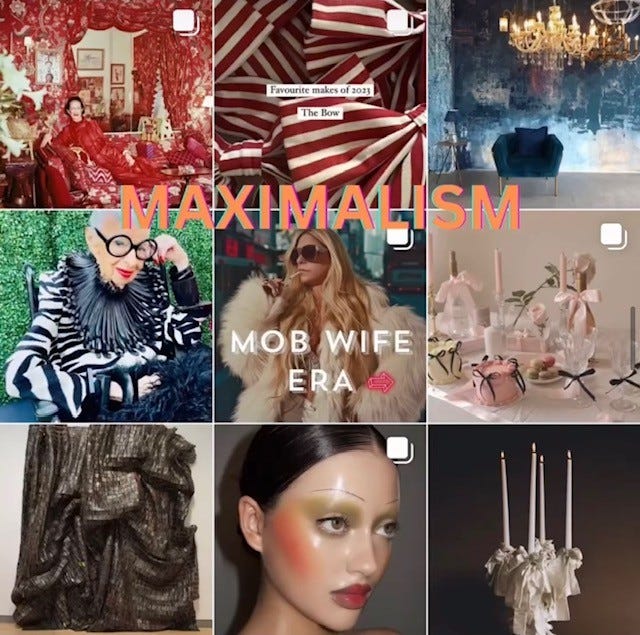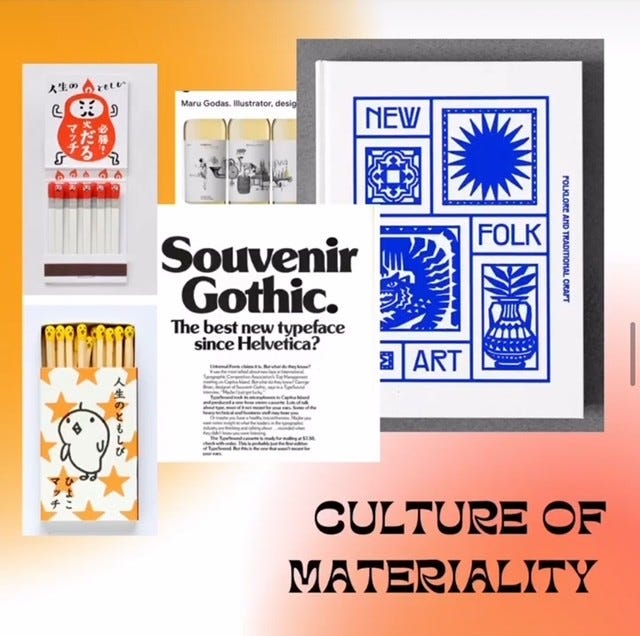Fruitmarket bookshop is a contemporary culture bookshop. Its more of a what’s good, what’s interesting? shop. But I call it a contemporary culture bookshop because it's built on the idea of holding a mirror to culture and its moving parts, and pulling themes and ideas out of it.
4 ideas I’ve been thinking a lot about lately are ones I discussed on my slot at EHFM’s International Womens’ Day programme. I discussed Maximalism, an idea I’ve called the Permacrisis Embedded, The Culture of Materiality, and The Witchy. They’re all in the shop right now in one way or another. They seem ever present at the moment, and also act as interesting starting points for thinking about larger concepts.
I’ll start with Maximalism. Because I love Maximalism. We opened this year with the ‘mob wife aesthetic, a viral trend in opposition to the digitally long-lived ‘clean girl aesthetic’. I’ll note just here, that digital culture is a major source for cultural trends right now. The digital landscape undeniably drives shifts in design, art, publishing, and fashion. So we opened the year going from neutral, quiet basics and barely there makeup to leopard print and red lipstick. These two trends were markers of larger trends in design and culture; Minimalism and Maximalism.
Minimalism and Maximalism regularly swing to their polemic sides in design, evoking references like Scandi design, Italian fashion, idealised lifestyles, and excess. I think this recent jaunt into Maximalism is a revisiting of the too-muchness of Baroque. The Baroque was born out of a post-plague Italy that further expanded the wealth gap divide and led to a time of extremes. We’re in similarly extreme, unprecedented times, and arts and culture has as usual created an interesting mirror for us to think about it.
This thread is thought through in Natalie Olah’s book Bad Taste. It sits within this theme of thinking via a socio-political lens with a focus on a working class aesthetic. Her theory based book marches into a sharp dismantling of a class-centred culture clash. She’s also cleverly covered the book in leopard print. When we showed Poor Things, a group show both curated and populated by working class artists, this subject came up a lot. The gallery was a Maximalist explosion of colour and noise, and it was wonderful. It was also a good place to start a conversation on who gets to say what’s good. Olah put her finger on the why of this concept. It's definitely worth a read.
Permacrisis Embedded, the next thread I’ll pull on, continues with the unprecedented times we live in. We have lived in a world that has experienced crisis after crisis. We are witnessing in real time, unimaginable tragedies. While working through this season’s new titles, I reflected on how much more serious my selections have become. I used to revel in irreverent print just because. Right now seems like it's more important than ever to build a bookshop that offers our audience a chance to discover texts that reflect our current times.
We recently showed Zarina Bhimji and Sarah Wood alongside each other. Zarina’s film and photographic work thought through the power of absence in the refugee experience. Wood asked what can artists do to help stop the Climate crisis. It felt like the gallery spaces were asking us as we passed, what can we do? What should we do? I wanted to extend this into the bookshop.
A title we have been selling lots of is Leah Thomas’ Intersectional Environmentalist. Its not only a beautiful book, but an immensely useful one. We also stock Rebecca Solnitt’s Hope in the Dark. Its an older title, but a great one to try and find a bit of light in an often hopeless place. N.K. Jemsin’s The City We Became imagines a world where people can become cities, and evil can use privilege and racism as a weapon to wield. I am also especially reveling in Fitzcaraldo’s selection of recent titles. They never miss. Their title Minor Detail by author Adania Shibli is an intelligent piece of writing that devastates and indirectly explores systemic erasure. These titles not only hold up a mirror to where we are, they interrogate it. They open up conversation, they are starting places much like Zarina and Sarah’s works were.
Next is the culture of Materiality. I think this is a new Arts and Crafts Movement, but its been pulled through a cultural landscape that is largely pervaded by the digital. In a time when AI is creating uncanny likenesses, texts, and convincing deep fakes, we have started to become suspicious. So we’re seeing a lot more illustration-based art. We’re seeking out the humanity in design, in marks made by the human hand. The Arts and Crafts Movement was a reaction against industrialisation, that sought to revive the importance of hand-made things. We are reviving the analogue and the material as a reaction to AI.
I have, through my years here, developed a group of makers. A lot of them were just starting when I found them. I am currently building up my makers mentorship programme to expand it because I think makers are vital to good and meaningful retail. Developing makers also contributes to a retail landscape where artists can build tenable careers while preserving their points of view. I prefer to buy directly from the artist when I can. I’m currently loving Joanna Blemont’s beautiful riso printed cards. They are quiet and lonely. Buying one of her cards is buying art you can bring into your life and share.
Lastly, the Witchy. There is such a big revival of the 90’s right now. In fashion especially. But we’re also seeing a revisiting of the 1990’s moral panic as well. In the 90’s it was Satanic cults. There was a fear and suspicion that your babysitter or neighbor or dad was going to be a devil worshiper. This fear was encapsulated in the 1996 film The Craft. The witchiness of the 90’s was one that was evil, dangerous, sexy, and also problematically using cultural appropriation very heavily.
The 90’s aesthetic of witchiness has returned, but this time, with a flicker of hope; a large swathe of contemporary witches are calling on their indigenous practises, and claiming their cultures. When I did my EHFM show, I played a song for each theme, and I played Princess Nokia’s ‘Brujas’. She speaks about her personal experience through Puerto Rican and West African Yoruban rituals and pulls them through the NY-centric filter of her life. Its a reclaiming. Her homemade and laid bare style of music is always a big wall of ideas and sound. Its a great summation of today’s witchiness.
I recommend Jenny Fagan’s fever dream of a book Hex to think on Scottish witchcraft. Fagan manages to convince you, in her fever dream of a novella, that traveling on elements like fire and air is a normal, every day occurrence. It is a book that contends with the violence wrought on women throughout Scottish history with a focus on the North Berwick witch trials. We also created a candle with artist Jill Smith. Smith’s career is defined by personal rituals that pull from the Scottish landscape and its history. Smith is not a witch, but her ritual-laden practise uses a lot of Scottish-Pagan influences associated with Scotland’s witchcraft scene. She has mapped out her Zodiac journey on the candle, and invites you to invent your own rituals with it. They are a limited edition, so buy one while they are here!
So that’s a few things that answer the questions, what’s good, what’s interesting, what’s relevant right now? Thinking through a shop, and pulling out concepts and ideas always brings forward more questions, but isn’t that delicious? And isn’t that what bookshops are for?
Links to these books can be found here.








